How innovative root research creates practical solutions
Written by Dr. Ulf Feuerstein • Asendorf, DSV Research Innovation Centre
The root system forms the starting point for a plant‘s performance. In the past it has been very difficult for breeders to select plants by root growth, but current research is now shedding new light in this field and creating new opportunities.
It’s the same spectacle year on year: swirling clouds of dust follow the giant combines as they harvest fields of cereal and oilseed rape. At harvest time little thought is given to the very organ of the plant on which this yield is built – the roots. Farmers, breeders and researchers however have ignored this invisible system in the past. It’s not that crop scientists are unaware of the root system’s role in crop yields, but up till now there has been a lack of systematic analysis. Growing underground, roots simply evade any obvious means of observing them and so efforts to measure and observe root development involve elaborate, time consuming procedures. A number of institutes have developed new methods which enable us to discover more about roots. Inspired by science and issues raised by farmers, breeders including Deutsche Saatveredelung AG are now starting to put roots at the centre of their breeding research programmes. The methods developed through scientific research, however, must be adapted to the high throughputs needed in plant breeding.
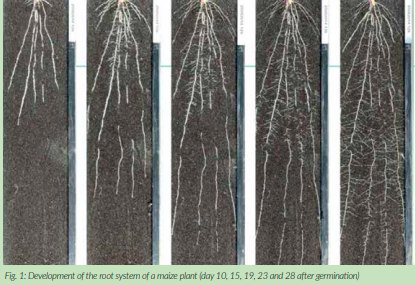
The radicle
Roots react more sensitively to different conditions than the plant’s organs above ground. Even minor differences in temperature, moisture, nutrient supply or soil compaction cause major variations in root growth. This root sensitivity makes it extremely difficult to conduct large-scale comparative studies. During the first few weeks, root growth can take place in special glasswalled containers known as rhizotrons. However, to investigate the root growth of older plants, the roots have to be extracted from the soil in the field. Seeds need water and the right temperature in order to germinate. Breeders know that roots respond to gravity and grow downwards towards the earth‘s centre – a phenomenon known as geotropism.
By placing seeds on filter paper arranged in an upright position, it is easy to observe how they germinate and how the radicle (the embryonic root) develops. Quick, uniform seed germination and strong radicle growth is important for a crop to become established. Every batch of seed will contain some seeds which germinate more quickly than others and produce a particularly strong radicle. Figure 2 illustrates the different rates of radicle growth of flax seedlings 48 hours after the start of germination. By observing different growth rates, breeders can select the plants which best match their breeding objectives and use them for further breeding trials.
Germination temperature
Temperature in particular has a major impact on the germination behaviour of seeds. Germination will not take place if the temperature is too low or too high. Each species has an optimum temperature range for germination and there are great differences even between individual varieties. A Kofler-style hot bench can be used to illustrate how seedlings develop at different rates according to their thermal requirements. A steel strip is selectively heated and cooled to produce a temperature gradient on its surface. At one end, for example, the temperature can be set to 6 °C and at the other, 25 °C. The surface is calibrated to indicate all the temperatures in between in equal increments. By placing the seed on these gradients, it is possible to observe the temperature at which a given variety first germinates and under what conditions it fails to germinate. A grid is placed over the hot bench to make it easier to identify the individual zones.
Making root growth visible in the rhizotron
Whilst the growth of the radicle is initially influenced by only a few factors, the positive – and negative – factors increase day by day. Therefore, it makes sense to continue observing root growth underground. The rhizotron was developed to bring a certain degree of consistency to the conditions and the observation process. Rhizotrons are flat, rectangular chambers with a sheet of glass on one side. They are filled with a special substrate which serves as a growing medium for the plants. Rhizotrons are inclined at an angle of 60° to exclude light and encourage the roots to grow along the panes of glass so that they can easily be observed. Figure 3 shows a pit containing rhizotrons planted with a variety of different legumes. Every three to seven days all the rhizotrons are photographed and the images are analysed using special software. The information about root growth rates and lateral root formation is vital for selection. Since minor differences in terms of soil content, watering and temperature cannot be ruled out entirely, it is necessary to repeat the trials several times before it is possible to assess the root growth of a particular variety correctly.
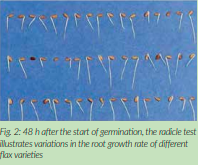
Figure 1 illustrates the dynamic root growth of a maize plant. It is wonderful to watch the lateral roots developing day by day and to see how the root system gradually expands to fill the available space. The rhizotron can be used to equally good effect to compare the roots of diploid and tetraploid varieties of perennial ryegrass. Perennial ryegrass is known to be relatively sensitive to periods of drought, with diploid varieties being particularly susceptible. By observing the root system of diploid and tetraploid ryegrass plants, it quickly becomes apparent that variations in drought tolerance can be explained by the characteristic shape of their root systems (Figure 4).
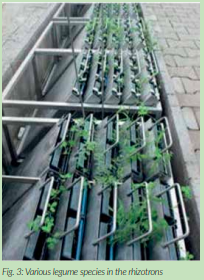
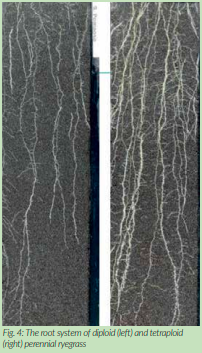
Roots in the field
The described methods enable breeders to gain insights into the early development of a plant’s root system. They are suitable for large-scale root studies and facilitate selection for specific traits even at this early stage in the breeding process. Ultimately, however, the strains selected by these methods have to be tested in the field and this step is extremely time-consuming. Non-destructive methods such as the use of x-rays or the measurement of electrical conductivity between the plant and the soil are still in their infancy and are being developed primarily for individual observations.
As yet, these methods are unsuitable for the types of large-scale studies that are required for breeding. All other methods currently available are destructive, i.e. the crop is no longer usable once the tests have been completed. The most widely used field-based method of root analysis still involves taking a soil core and carefully exposing the roots. But this approach is not suitable for breeding purposes since the level of intervention in the field needed for a large-scale study would be far too great, as would the effort required. The equally time-consuming sieving method, on the other hand, has proved effective. This involves removing the soil beneath the crop on a designated area in successive 10 cm increments. The soil is sieved out to expose the roots (Figure 5).
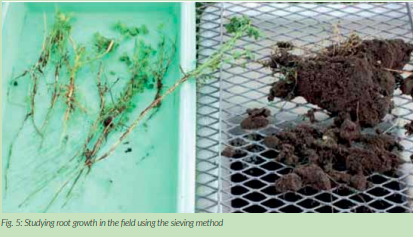
If the soil is very sticky, the roots will have to be washed. Since conditions in the field are never entirely uniform, several samples must be taken from each crop to obtain a valid root analysis. By calculating the root mass in conjunction with the mass of above-ground vegetation, it is possible to obtain a good indication of the growth of individual specimens. In a test series on two plots conducted at the DSV’s Hof Steimke breeding station in October, the root mass of a range of cover crops that had been sown in July was determined using the sieving method described above.

Table 1 shows variations in the distribution of the roots of individual species in different soil layers in sandy soil and loam. In the sandy soil, which tends to dry out quickly, on average 60 % of the roots were found in the 0–10 cm layer, whilst for the loamy soil this figure was 81 %. The lowest root penetration occurred in the 10– 20 cm layer for both soil types (16 % and 8 %). In contrast, root penetration increased again to 24 % and 11 % in the lowest layer of topsoil (20–30 cm).
Conclusion
Crop growers and breeders are increasingly turning their attention to the root. In the last few years, Deutsche Saatveredelung AG has developed a range of lab and greenhouse methods which are suitable for large-scale breeding studies. However, any form of root analysis conducted in the field is still very time-consuming, so plant breeders are keen to focus more strongly on this much neglected area. Why go to all this effort? Initially it was found that the root system has a major influence on yields, but this is only half the story. After all, the events that take place in the soil are extremely complex and the root is involved in multiple interactions with soil, nutrients and microorganisms. Legumes, for example, have a symbiotic relationship with bacteria called rhizobia which enables them to fix nitrogen. If legumes are mixed with grasses, the grasses also benefit from the interaction between the legumes and the rhizobia. More numerous interactions occur in mixes containing several different species, which is increasingly the case with cover cropping.
Deutsche Saatveredelung AG intends to gain a better understanding of the processes taking place in the soil around the roots (the rhizosphere) in order to select suitable strains for different growing conditions and soil types and make them available to growers.
